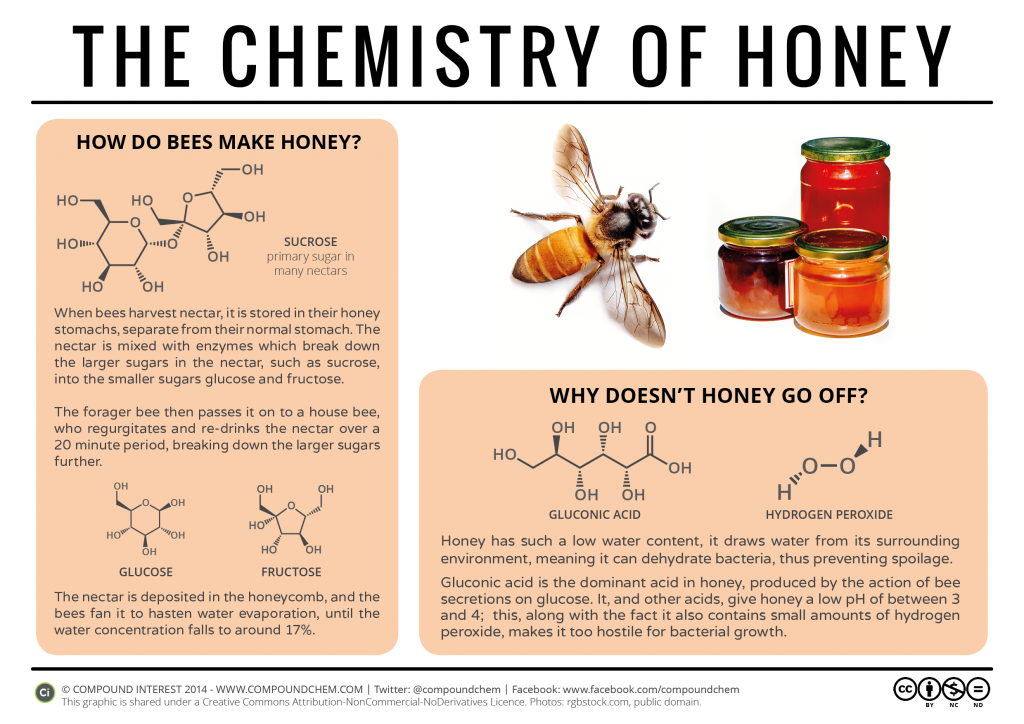The Chemistry of Honey
Honey is something of an oddity, in that, unlike most foods, it doesn’t spoil over time. In fact, the oldest known sample of honey, found in an Ancient Egyptian tomb and dated to approximately 3000 years ago, was still perfectly edible. What is it, then, that gives honey this unusual property?
To answer this question, we need to understand how bees make honey in the first place. Honey derives from plant nectar, which is a mix of various different sugars, proteins, and other compounds, in a water solution. Whilst nectar composition varies from plant to plant, and a range of chemical compounds are commonly present, often the dominant sugar is sucrose. This is actually exactly the same sugar as is found in your kitchen, as table sugar. The varying concentrations of the different components of nectar in different nectars is the reason that a range of types of honey are available, depending on which type of nectar the bees have predominantly been collecting.
Bees are the key intermediate step between nectar and honey. Worker bees will collect the nectar from flowers, and store it in their honey stomach – distinct from their normal stomach. Enzymes secreted from glands are then mixed with the nectar; these enzymes begin the breakdown of the sucrose in the nectar to simpler sugars. Sucrose is what we refer to as a disaccharide; it actually consists of two different simpler sugars, glucose and fructose, joined together. In the bee’s honey stomach, the sucrose molecules are gradually split by the enzymes into glucose and fructose.
Glucose and fructose can also be referred to as dextrose and levulose respectively. These two sugars are actually structural isomers, as they have the same chemical formula. The names ‘dextrose’ and ‘levulose’ refer to their effect on plane-polarised light. Due to the difference in the arrangement of the atoms, dextrose rotates plane-polarised light to the right, whilst levulose rotates it to the left. The prefixes ‘dextro-’ and ‘levulo-’ come from the latin for right and left respectively.
Once the worker bee returns to the hive, it will regurgitate the nectar solution and pass it on to one of the house bees, who remain in the hive. The house bee will continue the process the worker bee started – for up to 20 minutes, it will regurgitate and re-drink the nectar, continuing to mix it with enzymes and breaking it down further. Whilst some sucrose will remain, the majority is broken down into glucose and fructose.
Once suitable breakdown has been achieved, the house bee deposits the nectar into the honeycomb in the hive. Then another important step in the process begins. Nectar can be up to 70% water, and this water must be evaporated in order to produce the consistency of honey that we’re all familiar with. The bees achieve this by fanning the honeycomb with their wings in order to encourage rapid evaporation of the water from the nectar mixture. Eventually, the water content of the solution will drop to around 17%, vastly reduced from the content of the original nectar. The conversion of the watery nectar to syrupy honey takes between 1-3 days.
The water content of honey is a key factor in why it doesn’t spoil. At 17%, its water content is much lower than that of bacteria or fungi. Osmosis is a process of water moving from a high water potential (or concentration) to a low water potential. This is a similar concept to that of diffusion, where a substance will automatically spread out from an area of high concentration towards an area of low concentration, until the concentrations are eventually equal. Because honey has such a low water content it draws water via osmosis from any microorganisms, which have a higher water percentage, dehydrating them and either killing them or rendering them dormant, thereby preserving the honey. Because of its low water content, honey is hygroscopic – it absorbs water from the air – so it’s important to keep it in a sealed container to avoid this.
Another factor that helps honey avoid spoiling is its acidity. Its average pH is around 4; this acidity is contributed to by a number of acids, including formic acid and citric acid, but the dominant acid is gluconic acid, produced by the action of bee enzymes on some of the glucose molecules in the honey. This further boosts honey’s antibacterial properties, as many bacteria thrive in neutral rather than acidic conditions. Hydrogen peroxide is also produce by the production of gluconic acid – this too can inhibit the growth of bacteria. Honey’s antibacterial properties are actually potent enough for it to be effective as an impromptu wound dressing.
On a final note, you might also notice that, over time, honey tends to crystallise and solidify. Because honey’s water content is so low, it can be considered to be a super-saturated solution of the various sugars; a solution is considered saturated when as much solid as is possible has been dissolved in it. Over time, glucose will precipitate out of the solution, forming solid crystals. The honey is still perfectly fine to eat, and this doesn’t constitute spoilage – to revert it back to its liquid form, all that’s required is immersion in warm water for a few minutes.
Article shared with permission from Compound Interest.

